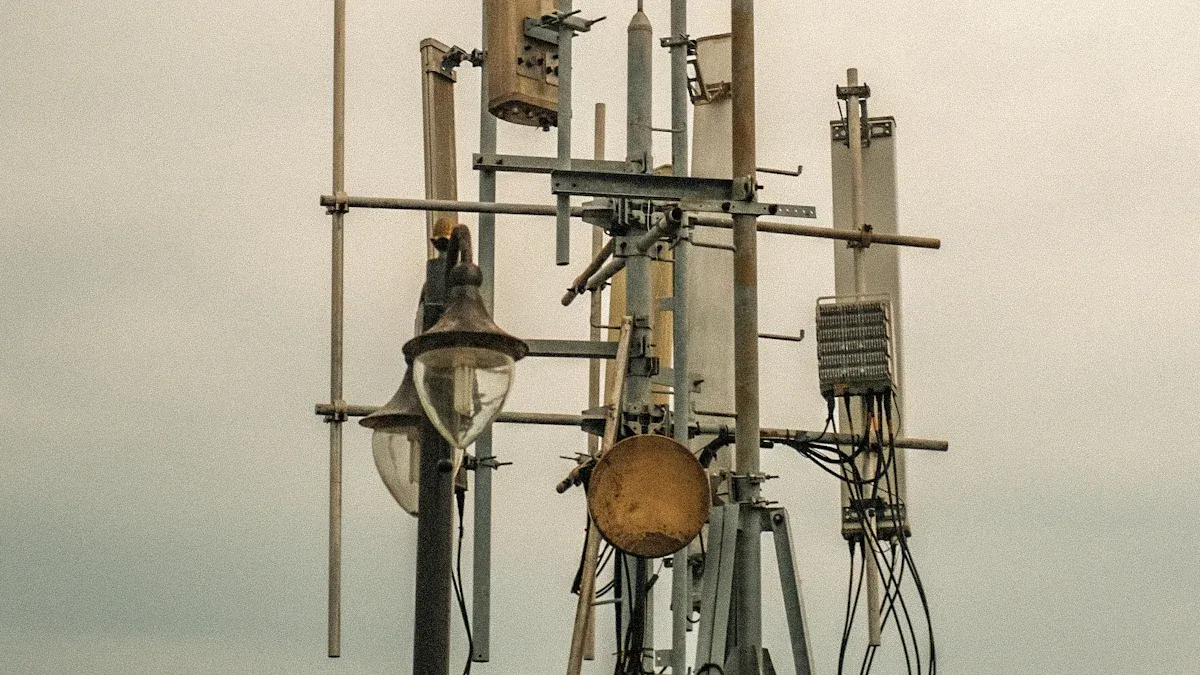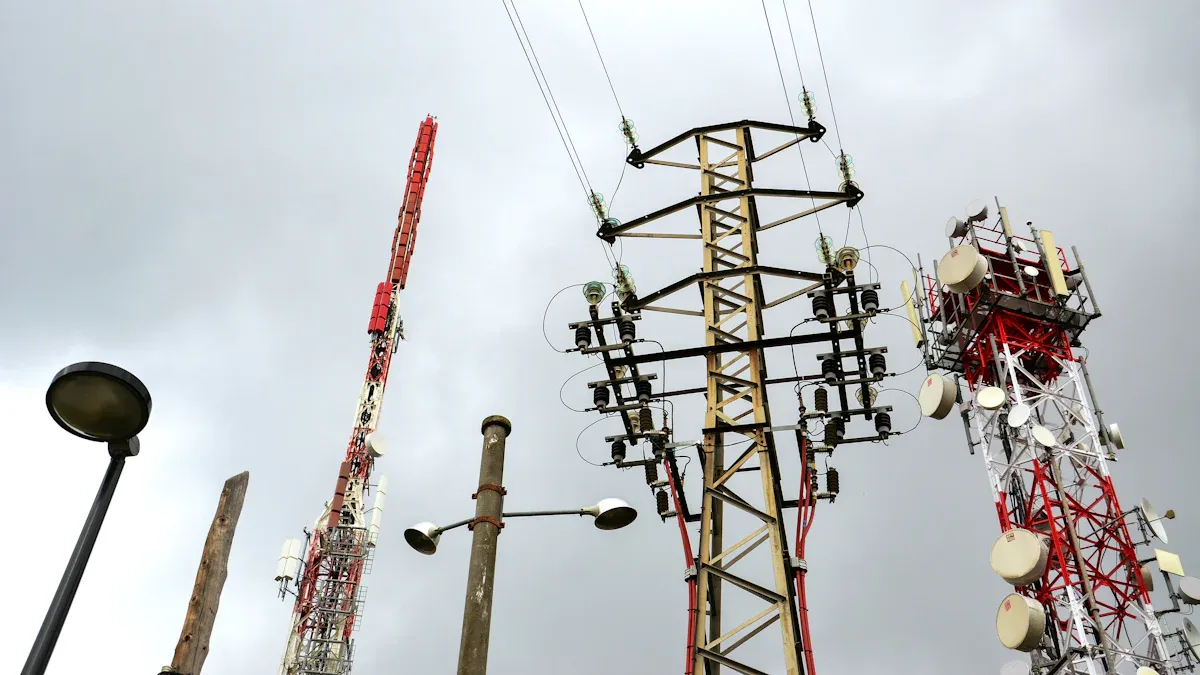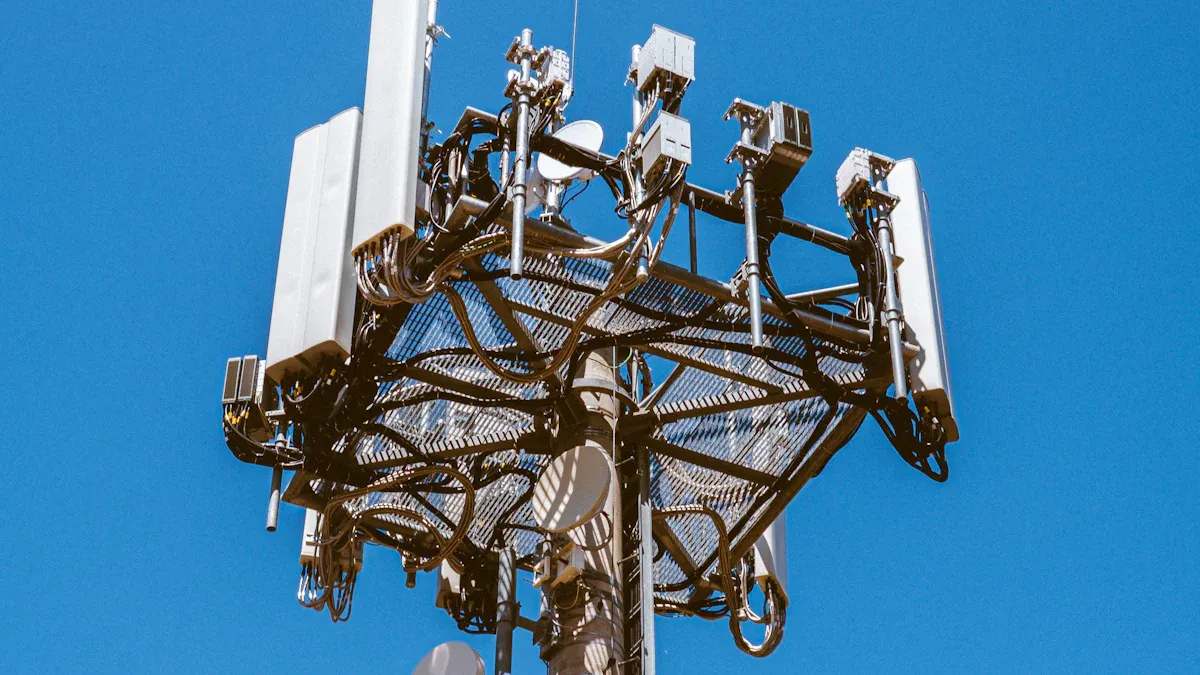Rectifier Comparison Guide for Modern Telecommunication Systems

Modern telecommunication systems rely heavily on switched-mode power supplies (SMPS), silicon-controlled rectifiers (SCR), and advanced MOSFET-based designs. These rectifier types deliver high efficiency and compactness, making them ideal for demanding telecom environments.
Recent advances in semiconductor materials, especially Gallium Nitride (GaN) and Silicon Carbide (SiC), have transformed the rectifier used in telecommunication:
Smaller, more efficient modules
Improved power density and reliability
Enhanced digital control and thermal management
Selecting the right rectifier demands attention to efficiency, reliability, and how well the device meets specific application needs.
Key Takeaways
Modern telecom systems rely on efficient rectifiers like SMPS, SiC, Schottky, and MOSFET-based types to save energy and reduce size.
Choosing the right rectifier depends on factors like efficiency, reliability, size, cost, and the specific telecom environment.
SMPS rectifiers offer high efficiency and compact design, making them ideal for central offices and remote sites.
SiC and Schottky rectifiers excel in harsh outdoor conditions by handling high temperatures and reducing cooling needs.
Modular and scalable rectifier systems help telecom networks grow smoothly while keeping maintenance low and uptime high.
Rectifier Types

Linear
Linear rectifiers use traditional transformer-based designs. They convert AC to DC with simple circuitry. These rectifiers offer low noise and stable output. Telecom systems once relied on linear rectifiers for their reliability. However, they have large size and low efficiency. Modern telecom equipment rarely uses linear rectifiers except in legacy systems or low-power backup circuits. Their main advantage lies in simplicity and ease of maintenance.
SCR (Silicon-Controlled Rectifier)
Silicon-controlled rectifiers (SCRs) provide robust power conversion for high-current telecom applications. They use thyristor technology to control the rectification process. SCR rectifiers handle large voltage and current loads, making them suitable for central office power plants and battery charging systems. Their ruggedness ensures long service life. However, SCR rectifiers operate at lower efficiency compared to modern switch-mode designs. They also require more space and generate more heat.
SMPS
Switched-mode power supply (SMPS) rectifiers dominate modern telecom systems. They use high-frequency switching to achieve compact size and high efficiency. SMPS rectifiers support a wide range of input voltages and deliver stable DC output. Telecom operators prefer SMPS for their low energy loss and flexible design.
Feature/Aspect | Description |
|---|---|
Very Low Forward Voltage Drop | Reduces conduction losses, enhancing overall system efficiency, especially in low-voltage, high-current applications. |
Extremely Low Switching Losses | Minimizes switching losses, ideal for high-frequency and fast-switching power converters typical of SMPS. |
High Surge Current Capability | Can handle up to 1,600 A peak surge current, ensuring robustness in demanding environments like telecom power supplies. |
Rugged Packaging (SOT-227B) | Provides effective heat transfer and electrical insulation, supporting reliable operation in harsh telecom environments. |
Fast Soft Recovery | Reduces electromagnetic interference (EMI) and switching noise, improving performance over standard diodes. |
Wide Operating Temperature Range | Ensures reliable operation from -55°C to +150°C, suitable for telecom systems with varying environmental conditions. |
Application in Telecom Systems | Specifically used in telecom power supplies for efficient high-current output stages, highlighting their critical role in such systems. |
Comparison to General Rectifiers | Offers enhanced efficiency and thermal performance, crucial for reliability and power efficiency in telecommunication systems. |
SMPS rectifiers deliver superior efficiency and thermal management. Their fast switching and compact design make them essential for modern telecom power supplies.
SiC Rectifier
Silicon carbide (SiC) rectifiers represent a leap forward in power electronics. SiC devices withstand higher voltages and temperatures than traditional silicon rectifiers. Telecom systems benefit from SiC rectifiers through improved efficiency and reduced cooling requirements. SiC rectifiers also enable higher power density, allowing for smaller and lighter power modules. These features make SiC rectifiers ideal for next-generation telecom infrastructure, especially in outdoor or high-temperature environments.
Schottky Diode
Schottky diode rectifiers, especially those based on SiC technology, play a key role in telecom base stations and networking equipment.
Schottky diodes provide higher efficiency and power density, enabling more compact and reliable telecom infrastructure.
SiC-based Schottky Barrier Diodes (SBDs) reduce power conversion losses, resulting in lower operating temperatures.
These rectifiers help telecom operators save energy and reduce cooling costs.
Improved efficiency and thermal performance support operational cost savings and environmental sustainability goals.
Schottky diodes excel in high-frequency, low-voltage applications. Their fast switching and low forward voltage drop make them a preferred choice for modern telecom rectifiers.
MOSFET-Based
MOSFET-based rectifiers use advanced semiconductor switches to achieve high-speed, low-loss power conversion. These rectifiers operate efficiently at high frequencies, supporting compact and lightweight designs. Telecom systems use MOSFET-based rectifiers in distributed power architectures and high-efficiency DC-DC converters. Their precise control and fast response improve power quality and system reliability. The adoption of GaN and SiC MOSFETs further enhances performance, allowing telecom equipment to meet increasing power demands without sacrificing efficiency.
Note: The choice of rectifier technology directly impacts the efficiency, reliability, and scalability of telecom power systems. Advanced materials and device structures, such as SiC and Schottky, continue to drive innovation in this field.
Key Criteria
Efficiency
Efficiency remains a top priority in telecom rectifier selection. High-efficiency rectifiers reduce energy loss and lower operational costs. Schottky diode modules, such as the DSA240X200NA and DSS2x101-02A, demonstrate outstanding performance in this area. Their low forward voltage drop and minimal switching losses enable superior energy conversion. The following table compares key parameters:
Parameter | DSA240X200NA (Dual Schottky Diode) | DSS2x101-02A (Dual Schottky Diode) |
|---|---|---|
Reverse Voltage (VRRM) | 200 V | 200 V |
Average Forward Current | 2 × 120 A (240 A total) | 2 × 100 A (200 A total) |
Peak Surge Current | Up to 1,600 A | Up to 1,300 A |
Forward Voltage Drop (VF) | ~1.0 V @ 120 A | ~0.93 V @ 100 A |
Switching Losses | Extremely low | Very low |
Thermal Resistance (RθJC) | About 0.4 K/W | About 0.5 K/W |
Max Junction Temperature | 150 °C | 150 °C |
These characteristics support efficient heat dissipation and reliable operation at high currents.
Reliability
Telecom networks demand rectifiers that operate continuously without failure. SCR and SiC rectifiers offer robust construction and long service life. Schottky and MOSFET-based rectifiers also provide high reliability, especially in environments with frequent power fluctuations.
Size & Weight
Modern telecom equipment requires compact and lightweight power solutions. SMPS, SiC, and MOSFET-based rectifiers deliver high power density in small packages. This advantage allows for easier installation and space savings in crowded racks.
Cost
Cost considerations influence rectifier choice. Linear and SCR rectifiers often have lower upfront costs but may incur higher energy expenses over time. SMPS and SiC rectifiers require a higher initial investment but deliver savings through improved efficiency and reduced cooling needs.
Maintenance
Low-maintenance rectifiers reduce downtime and service costs. SMPS and Schottky rectifiers feature fewer moving parts and advanced thermal management, minimizing maintenance requirements. Legacy linear rectifiers may need more frequent servicing.
Power Quality
Stable power output ensures reliable telecom operation. MOSFET-based and SMPS rectifiers provide precise voltage regulation and low noise. Schottky diodes contribute to clean DC output, supporting sensitive telecom electronics.
Scalability
Telecom networks grow rapidly. Scalable rectifier solutions, such as modular SMPS and MOSFET-based designs, allow operators to expand capacity without major infrastructure changes. This flexibility supports future network upgrades.
Rectifier Used in Telecommunication
Central Office
Central offices form the backbone of telecommunication networks. These facilities require reliable and scalable power systems to support large volumes of voice and data traffic. Engineers often select SMPS rectifiers for central office installations. These rectifiers deliver high efficiency and compact size, which helps maximize rack space. SCR rectifiers also appear in legacy systems due to their robust performance and ability to handle high current loads.
Central offices demand uninterrupted service. Operators choose rectifier used in telecommunication that can provide redundancy and hot-swappable modules. This approach ensures continuous operation during maintenance or upgrades.
A typical central office power system includes:
Modular SMPS rectifiers for main DC power
SCR rectifiers for battery charging and backup
Monitoring systems for real-time diagnostics
The combination of these rectifier types supports both legacy and modern telecom equipment, ensuring smooth transitions during network upgrades.
Remote Site
Remote sites, such as cellular base stations and repeater huts, present unique challenges. These locations often lack easy access to maintenance and may experience harsh environmental conditions. The rectifier used in telecommunication at remote sites must offer high reliability and minimal maintenance.
SMPS rectifiers dominate remote site deployments. Their lightweight and compact design simplifies installation in small enclosures. SiC rectifiers and Schottky diodes further enhance efficiency, reducing the need for active cooling. Operators value rectifiers with wide input voltage tolerance, as power quality can fluctuate in remote areas.
Key features for remote site rectifiers include:
High efficiency to minimize energy consumption
Wide temperature range operation
Remote monitoring and control capabilities
These features help reduce operational costs and extend service intervals, making remote site management more efficient.
Data Center
Data centers serve as the nerve centers for digital communication. They require precise power management to support servers, storage, and networking equipment. The rectifier used in telecommunication within data centers must deliver stable, clean DC power with minimal noise.
Engineers prefer MOSFET-based and SMPS rectifiers for data center applications. These rectifiers provide high-frequency operation, excellent voltage regulation, and low electromagnetic interference. SiC rectifiers also gain popularity due to their ability to handle high power densities and reduce cooling requirements.
Rectifier Type | Key Benefit in Data Centers | Typical Use Case |
|---|---|---|
SMPS | High efficiency, modularity | Main DC power supply |
MOSFET-based | Fast switching, low noise | DC-DC converters, blade servers |
SiC | High power density, thermal savings | High-load racks, UPS systems |
Data center operators prioritize rectifiers that support scalability and remote diagnostics. These features enable rapid expansion and proactive maintenance, which are critical in high-availability environments.
Outdoor/Harsh
Outdoor and harsh environments, such as telecom towers, roadside cabinets, and rural installations, expose equipment to extreme temperatures, humidity, and dust. The rectifier used in telecommunication for these settings must withstand these challenges while maintaining reliable performance.
SiC rectifiers excel in outdoor applications due to their wide operating temperature range and resistance to thermal stress. Schottky diodes also perform well, offering low forward voltage drop and fast recovery times. Engineers often select ruggedized SMPS rectifiers with conformal coatings to protect against moisture and contaminants.
Tip: For outdoor deployments, always choose rectifiers with IP-rated enclosures and enhanced surge protection.
Essential characteristics for outdoor rectifiers include:
Robust packaging and environmental sealing
High surge current capability
Minimal maintenance requirements
These attributes ensure long service life and reduce the risk of power interruptions in critical telecom infrastructure.
Comparison Table

Selecting the right rectifier for telecom systems requires a clear understanding of each type’s strengths and limitations. The table below provides a side-by-side summary of the most common rectifier types used in modern telecommunication environments.
Rectifier Type | Voltage Handling | Efficiency | Switching Frequency | Application Suitability |
|---|---|---|---|---|
Linear | Low (≤ 100 V typical) | Low (60–70%) | 50/60 Hz (line freq.) | Legacy, low-noise, backup circuits |
SCR | High (up to 600 V+) | Moderate (75–85%) | Low (line freq.) | Central office, battery charging |
SMPS | Medium-High (85–400 V) | High (85–95%) | High (20–500 kHz) | Central office, remote site, data center |
SiC Rectifier | Very High (600–1700 V) | Very High (up to 98%) | Very High (100 kHz+) | Outdoor, harsh, high-density systems |
Schottky Diode | Medium (up to 200 V) | Very High (up to 98%) | Very High (100 kHz+) | SMPS, remote site, high-efficiency DC |
MOSFET-Based | Medium (up to 200 V) | Very High (up to 98%) | Very High (100 kHz+) | Data center, distributed power, DC-DC |
Note: Schottky diode modules, such as the DSA240X200NA, deliver excellent voltage handling with a 200 V rating and can manage peak surge currents up to 1,600 A. Their low forward voltage drop and extremely low switching losses make them ideal for high-frequency, high-efficiency telecom applications.
Linear rectifiers offer simplicity but fall short in efficiency and voltage range.
SCR rectifiers handle high currents and voltages but operate at low frequencies.
SMPS, SiC, Schottky, and MOSFET-based rectifiers excel in efficiency and compactness, supporting modern telecom needs.
SiC and Schottky devices enable higher switching frequencies, which reduces size and improves thermal management.
This comparison helps telecom engineers match rectifier technology to specific operational requirements, ensuring reliable and efficient power delivery across diverse network environments.
Pros & Cons
Linear
Pros:
Simple design makes troubleshooting and repairs straightforward.
Low output noise benefits sensitive telecom circuits.
Proven reliability in legacy systems.
Cons:
Large size and heavy weight limit use in modern compact installations.
Low efficiency increases energy costs and heat output.
Limited scalability for growing telecom networks.
SCR
Feature | Benefit / Explanation |
|---|---|
Very Low Forward Voltage Drop | Reduces conduction losses, improving efficiency in telecom power supplies. |
Extremely Low Switching Losses | Enhances efficiency and thermal performance in high-frequency telecom converters. |
High Surge Current Capability | Handles up to 1,600 A peak surge current, ensuring robustness in fault-prone telecom environments. |
Rugged Packaging (SOT-227B) | Provides effective heat transfer and electrical insulation, improving reliability in telecom setups. |
High Isolation Voltage (3,000 V RMS) | Enhances safety in grounded heatsink designs common in telecom rectifiers. |
Fast Soft Recovery | Reduces EMI and switching noise, beneficial for telecom system stability. |
Wide Operating Temperature Range | Ensures reliable operation in harsh telecom environments. |
Low Thermal Resistance | Enables compact, thermally efficient designs with minimal cooling, important for telecom equipment. |
Field data shows SCR rectifiers deliver high efficiency and reliability, especially when paired with SiC semiconductors. They support compact, energy-efficient telecom infrastructure. However, SCR rectifiers may not match the switching speed or compactness of newer SMPS or MOSFET-based designs.
SMPS
Pros:
High efficiency reduces energy loss and operational costs.
Compact size fits modern telecom racks and enclosures.
Wide input voltage range supports global deployments.
Modular design allows easy scalability.
Cons:
Complex circuitry can increase repair time.
High-frequency switching may introduce EMI if not properly managed.
SiC
SiC rectifiers provide higher efficiency and power density in telecom systems.
They enable more compact and reliable infrastructure.
SiC components generate less heat, reducing cooling needs and operational expenses.
Improved efficiency lowers energy consumption, supporting cost savings.
These benefits help telecom operators meet environmental sustainability goals.
Cons:
Higher initial cost compared to traditional silicon rectifiers.
Limited availability in some markets.
Schottky
Pros:
Very low forward voltage drop increases efficiency.
Fast switching supports high-frequency telecom applications.
Low heat generation reduces cooling requirements.
Cons:
Lower voltage ratings than SiC or SCR rectifiers.
May have higher leakage current at elevated temperatures.
MOSFET
Pros:
High-speed switching enables precise voltage regulation.
Excellent efficiency in DC-DC conversion.
Compact and lightweight, ideal for dense telecom installations.
Cons:
Sensitive to voltage spikes and static discharge.
May require advanced control circuitry for optimal performance.
Choosing the Right Rectifier
Decision Factors
Selecting the optimal rectifier for a telecommunication system requires careful evaluation of several critical factors. Each telecom environment presents unique challenges, so engineers must match rectifier features to operational needs. The following decision factors guide the selection process:
Application Environment
Central offices, remote sites, data centers, and outdoor installations each demand specific rectifier characteristics. For example, outdoor sites require devices with wide temperature tolerance and robust packaging.Efficiency Requirements
High-efficiency rectifiers reduce energy consumption and lower operational costs. Telecom operators often prioritize efficiency to meet sustainability goals and minimize heat generation.Reliability and Uptime
Continuous operation remains essential in telecom networks. Rectifiers with proven reliability, such as SCR or SiC-based designs, help maintain network availability.Scalability and Modularity
Networks grow over time. Modular rectifier systems allow for easy expansion and maintenance without disrupting service.Physical Constraints
Space and weight limitations influence rectifier choice. Compact SMPS and MOSFET-based rectifiers fit well in dense rack environments.Cost Considerations
Initial investment and long-term operational expenses both impact the total cost of ownership. While advanced rectifiers may cost more upfront, they often deliver savings through improved efficiency and reduced maintenance.
Tip: Always assess the compatibility of the rectifier used in telecommunication with existing infrastructure and future upgrade plans.
Telecom professionals should select the rectifier used in telecommunication based on efficiency, reliability, and application environment. SMPS and MOSFET-based rectifiers suit data centers and remote sites, while SiC and Schottky devices excel in harsh or high-density settings. Regularly reviewing new materials and technologies ensures optimal performance.
For best results, engineers should match rectifier features to current needs and anticipate future network demands.
FAQ
What rectifier type offers the best efficiency for telecom systems?
SMPS, SiC, and Schottky rectifiers deliver the highest efficiency in telecom applications. These devices minimize energy loss and reduce heat, making them ideal for modern, high-density installations.
How often should telecom rectifiers undergo maintenance?
Most modern rectifiers, such as SMPS and Schottky types, require minimal maintenance. Operators typically schedule inspections every 6 to 12 months. Regular monitoring helps ensure reliable performance and early detection of potential issues.
Can telecom operators mix different rectifier types in one system?
Yes, engineers often combine rectifier types. For example, they may use SMPS for main power and SCR rectifiers for battery backup. This approach supports both legacy and modern equipment within the same facility.
Why do outdoor telecom sites prefer SiC rectifiers?
SiC rectifiers withstand extreme temperatures and harsh conditions. Their robust design ensures reliable operation in outdoor environments. Operators choose SiC devices to reduce cooling needs and extend service life in challenging locations.
See Also
An Introductory Overview Of Telecom Power Supply Basics
Key Information About Features Of Telecom Power Supplies
A Clear Explanation Of Global Standards For Telecom Power
Methods For Calculating Telecom Cabinet Power And Battery Needs
Steps To Guarantee Stable Power Supply Within Telecom Cabinets
CALL US DIRECTLY
86-13752765943
3A-8, SHUIWAN 1979 SQUARE (PHASE II), NO.111, TAIZI ROAD,SHUIWAN COMMUNITY, ZHAOSHANG STREET, NANSHAN DISTRICT, SHENZHEN, GUANGDONG, CHINA
